
A swimming hole is a place in a river, stream, creek, spring, or similar natural body of water, which is large enough and deep enough for a person to swim in. Common usage usually refers to fresh, moving water and thus not to oceans or lakes.

The Loddon River, an inland river of the north–central catchment, part of the Murray-Darling basin, is located in the lower Riverina bioregion and Central Highlands and Loddon Mallee regions of the Australian state of Victoria. The headwaters of the Loddon River rise on the northern slopes of the Great Dividing Range east of Daylesford and descend to flow north into the Little Murray River, near Swan Hill. The river is impounded by the Cairn Curran and Laanecoorie reservoirs.
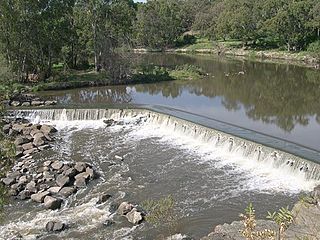
Dights Falls is a rapid and weir on the Yarra River in Melbourne, Victoria, just downstream of the junction with the Merri Creek. At this point the river narrows and is constricted between 800,000-year-old volcanic, basaltic lava flow and a much older steep, silurian, sedimentary spur. The north side also contains abundant graptolite fossils in sedimentary sandstone.

Saratoga Spa State Park is a 2,379-acre (9.63 km2) state park located in Saratoga County, New York in the United States. The park is in the City of Saratoga Springs, near US 9 and NY 50.
The Melbourne Sports and Entertainment Centre is a sports administration and training facility located in the Melbourne Sports and Entertainment Precinct in Melbourne, Australia. The facility opened in 1956 as an aquatic centre for the 1956 Olympic Games. In 1983, the Olympic-sized pool was replaced with a parquetry floor and the facility became Melbourne's home of numerous basketball events until 1998, most notably as the home venue for several National Basketball League teams including the North Melbourne Giants and Melbourne Tigers. The venue served as Melbourne's primary indoor concert arena from 1984 to 1988, until completion of the Rod Laver Arena.

Hepburn Springs is a resort town located in the middle of the largest concentration of mineral springs in Australia, situated in Victoria, 48 km northeast of Ballarat. At the 2021 census, Hepburn had a population of 631, and Hepburn Springs had a population of 368. The total population of Hepburn Springs was 928. The town is named after Captain John Hepburn, who was an early squatter in central Victoria. The traditional owners of the land are the Dja Dja Wurrung.
The Hepburn Mineral Springs Reserve is a 30-hectare (74-acre) reserve near Hepburn Springs, Victoria, Australia. It contains several mineral springs that have been used for drinking and bathing since the 1860s. The site is listed on the Victorian Heritage Register and forms part of Hepburn Regional Park.
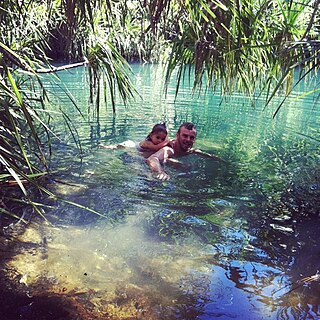
Berry Springs is a locality in the Northern Territory of Australia. The locality is a mostly rural area situated on the Cox Peninsula Road and is sparsely populated. A few businesses and a school are located in the locality. In the 2016 census, the population of Berry Springs was 818. It is located 58.5 kilometres (36.4 mi) by road from the Darwin Central Business District and lies within the Litchfield Municipality local government area.

The Hepburn Wind Project is a wind farm built and owned by Hepburn Wind, a community co-operative, and supported by the Victorian Government. The location of the project is Leonards Hill, 10 kilometres (6.2 mi) south of Daylesford, Victoria, north-west of Melbourne, Victoria. It comprises two individual 2.05 MW wind turbines supplied by REpower System AG which are projected to produce enough energy for 2,300 households, almost as many houses are in the twin-towns of Daylesford and Hepburn Springs.
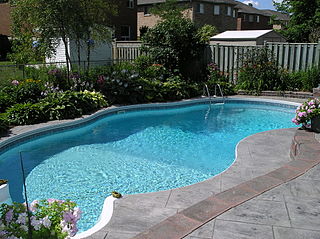
A swimming pool, swimming bath, wading pool, paddling pool, or simply pool, is a structure designed to hold water to enable swimming or other leisure activities. Pools can be built into the ground or built above ground, and may be found as a feature aboard ocean-liners and cruise ships. In-ground pools are most commonly constructed from materials such as concrete, natural stone, metal, plastic, composite or fiberglass, and can be of a custom size and shape or built to a standardized size, the largest of which is the Olympic-size swimming pool.
Swiss Italians of Australia are the Italian-speaking Swiss who settled in Australia during the 1850s and 1860s and their descendants who identified as such.
The Blowhole diversion tunnel is located on the Sailors Creek, Hepburn, Victoria, Australia. The creek flows around a spur in a horseshoe bend. The tunnel was driven through the spur diverting the river and allowing the exposed river bed to be sluiced for alluvial gold. It "was probably built in the early 1860s when Jim Crow Creek was being extensively worked by European and Chinese miners".
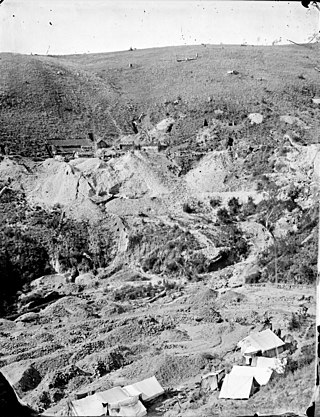
The Jim Crow goldfield was part of the Goldfields region of Victoria, Australia, where gold was mined from the mid- to the late-nineteenth century.

The Harold Holt Memorial Swimming Centre is a public swimming pool complex located on the corner of High Street and Edgar Street, Glen Iris, Melbourne, Australia. Built in the 1960s by Australian architects Kevin Borland and Daryl Jackson, the Swimming Centre is considered to be a fine example of Brutalist architecture. Originally built in 1927 as a municipal swimming baths, the facilities were renovated in 1967 by Borland and Jackson to accommodate for higher swimming participation numbers. It is named in honour of Prime Minister Harold Holt, the local member of parliament until his apparent drowning death while the facility was under construction.

Mount Franklin is an extinct volcano about 10 km north of Daylesford and 4.6 km south east of Franklinford in Victoria, Australia. A road spirals round the outside slopes covered with pine trees, into a flat 50 acre caldera, and onto the rim which hosts a fire lookout, parking area and picnic ground.
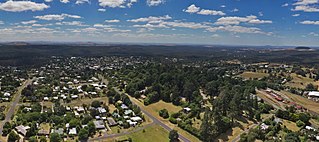
The Wombat Hill Botanic Gardens in Daylesford, Victoria, Australia, are included on the Victorian Heritage Register.
Lisa Gervasoni is currently the Senior Stakeholder Policy and Advocacy Advisor at the Victorian Farmers Federation. Gervasoni is strategic planner, photographer and artist. She was born in Melbourne, Australia. Gervasoni is part of a long family tradition of working with heritage sites in Australia. She is a member of ICOMOS and was a 2-term member of their executive committee. She has been a keynote speaker in Victoria, Australia. Gervasoni was instrumental in getting Hepburn Pool listed on the Victorian Heritage Register.
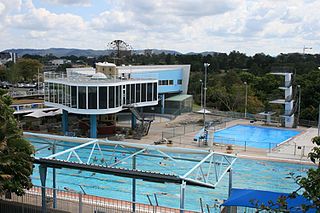
Centenary Pool Complex is a heritage-listed swimming pool at 400 Gregory Terrace, Spring Hill, City of Brisbane, Queensland, Australia. It was designed by architect James Birrell and built in 1959. It was added to the Queensland Heritage Register on 5 November 1996.
Strangways is a locality within the local government area of Mount Alexander, in Central Victoria, Australia. It covers an area of 20.105 square kilometres between the townships of Guidford to the east, Newstead to the north-west and Clydesdale to the south.
















